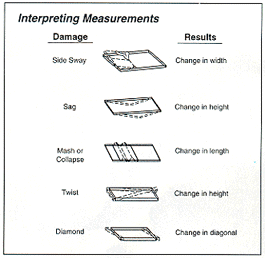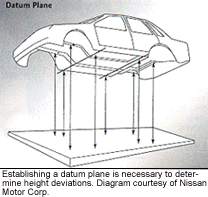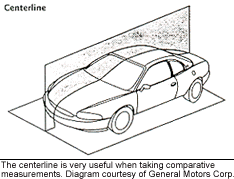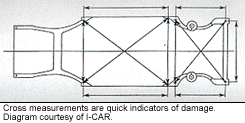Have you ever wondered how far a builder will go to ensure a true foundation is in place for a high-rise building? A quality-minded builder will check whether the structure is plumb, square and level as it rises skyward. Suffice it to say, the extent to which a builder will go is significant. Some even go so far as to alleviate costly potential problems by using labor-intensive solutions — decreasing the profitability of the enterprise.
Though collision repair shops must keep both production and profitability in mind, the work a technician does to rebuild a damaged automobile is quite similar to that of a builder. It’s imperative that we approach a collision-damaged automobile structure with the same diligent attitude a builder takes with his structure. Even though a builder isn’t repairing a severely damaged structure — like a technician does — the principle remains the same. We need to ensure a true foundation, in respect to datum (height), length and width (sway) before we proceed with welding the replacement parts to the structure. If you don’t do this, you can be sure problems will crop up like desert flowers after a long awaited rain (only, the problems you’ll have aren’t pretty to look at).

Do It Once and Do It Right
When we opt to delete the measuring option in the preliminary stages of a repair because the structure "looks" pretty good, we hope for the best and, in turn, open ourselves up to failure upon completion of the job.
"What does he consider failure?" you ask.
Consider failure as making pulls to achieve alignment — after the job is welded together. Yes, the job gets done, but at what cost in time, quality of repair and friction? When I refer to friction, I’m not talking about one part rubbing against another. Instead, your inability to properly plan and diagnose a job is rubbing against the boss’ desire for efficient production, smooth job flow and enhanced cycle time.
As a 37-year veteran of this industry, let me suggest that you do everything you can on the front end of the job — measure and diagnose — to ensure success — no friction, everything fits — on the back end of the job. Forget about hope and use skill instead. You’ll like the result, and so will the boss.
A suspension alignment technician recently asked me, "How come we seldom have problems aligning your work? We’re always having some kind of a problem with the majority of the repairers."
I replied, "It’s no secret. We just measure the jobs before, during and after the repair and make corrections accordingly."

The Laziness Factor
I think most foundation problems are rooted in a poor understanding of automotive geometry, possibly greed and, yes, some laziness, too. Many frame equipment manufacturers have told me that a significant number of technicians use the straightening equipment but not the measuring equipment. That equipment gathers dust in the corner or hanging on the wall.
That’s not good.
I can’t do anything about the greed factor except to tell you that if you’re good, proficient and thorough at what you do, you’ll always be faster than someone who has to slot holes, cheat gaps and pull to align the structure after the car is welded together.
If laziness is the problem, think about it. What’s easier: a few hours of measuring and alignment or untold hours of fighting the job because of a misaligned structure? l know some of the problems aren’t just physical laziness but mental laziness as well, which can be equated with fear of the unknown. Because we haven’t attained a good understanding of collision geometry, we shy away from measuring to avoid thinking about applying the unknown. Thinking is hard work.
Perhaps I can help you with automotive geometry. All, yes all, successful frame and structural technicians have a good understanding of this subject. They may not call it geometry (though, that’s exactly what it is), but they know how to measure an automobile to find collision-related damage not obvious to the eye. That’s where many technicians have problems later in the job. It’s the unseen or missed damage only picked up by measuring that gets overlooked, until the suspension alignment tech calls, or the hood or door won’t fit.
Let me put you at ease. I’m not a mathematician. I’m not a scientist. I’m a collision repair technician who can write. (I’m Irish, so I was born that way. We Irish like collisions and all things literary.) I love my work and to do that, I must understand it. I don’t care if you’re a 40-year veteran or a "newbie," take some time to think about what we do and how we approach it.
To explain, I’ll break this down into the simplest components possible.

Visualize Every Dimension
Let’s talk unibody, although these same principles apply to frame cars as well.
Think of the platform of the automobile (floor pan, torque box, rails) as a rectangle. Draw it on paper if it helps to visualize. View it as a 3-D object in respect to datum (height), width (sway) and length.
We should have two perspectives of our rectangle: one from the side, in which we can measure the height of our platform, and one from below, from which we can measure the length of the platform and the sway, right or left.
We measure height from an imaginary plane that runs parallel and beneath our rectangle. We can view this from the side, front and rear. This is called the datum plane. Draw it beneath the side view of your rectangle or platform.
Divide your rectangle precisely in half, with a line that runs from the front to the rear of the rectangle. This is called the centerline. Measurements can be taken from the right side of our rectangle or platform and compared to those on the left side to determine if there are deviations from one side to the other. This is called sway, or the amount the automobile is to the right or left of the centerline.
You can also detect sway by measuring diagonally from a common point beneath the cowl on the left side of the vehicle to a point beneath the radiator core support on the right side. Then compare this measurement with the same locations on the opposite side of the car. These cross measurements and quick indicators can be done with a tape or tram bar and will indicate unseen damage.
Length measurements are taken from a common point on the front of the left side to a common point on the rear of the left side. This is then compared to measurements at corresponding locations on the right side. Differences here indicate mash, or that one side is shorter than the other.
Note: The aforementioned description assumes that all points, right to left, are symmetrical.
It’s that basic. Everything stems from these basics, so don’t make it more complex than it is. Let that soak in and think of it often until you grasp the concept of measuring. You truly need to understand this before you can consistently and successfully repair collision-damaged structures.

Measuring Correctly
Now that you have a basic understanding of the measuring process, how do you go about actually measuring?
There are many systems on the market used to determine the described measurements. Generally speaking, cost can relate to ease of use and efficiency. Some expensive systems are quick to set up and determine deviations in the structure with ease. Less expensive systems often require more setup time and more interpretive skill by the operator. Your equipment choice depends on your skill level and the needs of your shop. The accuracy of the measurements, for the most part, depends upon the diligence and care of the person measuring.
Laser measuring, ladder-bar mechanical measuring, sonar and even bar codes can be employed along with tram gauges and frame gauges to accomplish the task.
Please, don’t let yourself be intimidated by these devices. Otherwise, they’ll sit in the corner and the inherent problems of not measuring will occur.
Study the manuals provided with these systems, get training at factory schools, have the factory reps conduct shop training and, above all, understand how the particular system you’re using accomplishes the basic task you need: 3-D measuring.
Even with all the right tools, you still may run into some difficult measuring jobs. Upperbody measurements can be a challenge with less sophisticated systems that don’t have adequate capability.
Some hard and high cowl hits (hinge pillar, A pillar) are also perplexing to techs, as are latch pillar (B pillar and C pillar) hits. But there’s no need to get frustrated and quit. Remove the seats and find a common undamaged point in the sill panel area on each side of the car. To be accurate, it’s important that the points are common and symmetrical. Take your tram gauge and place it on the common point on the left sill panel with the other end of the tram. Then strike an arc in the underseat area. Now, go to the common point on the right sill and intersect the arc from the left side. Where those arcs intersect is the center of the car. Punch it, drill a small hole or insert a screw there. This will be the point where you take comparative measurements from the undamaged side of the car to the damaged side. When the two lengths are equal, you’ve achieved your goal in that area.
Knowledge Is Power
None of this takes into account the methods of straightening, repairing, pulling, counter-supporting, clamping or stress relieving, which are necessary to achieve a true foundation for a successful repair. Each of those subjects are stories of their own.
But you now understand the basics of measuring and, with some thought and a little study, you can apply that knowledge to the next measuring job that comes your way.
And really, isn’t knowing half the battle in this industry?
Writer Mike West, a contributing editor to BodyShop Business, has been a shop owner for the past 25 years and a technician for 34 years. His shop in Seattle, Wash., has attained the I-CAR Gold Class distinction and the ASE Blue Seal of Excellence.













